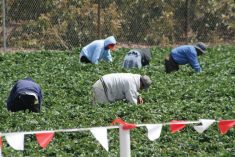Despite significant interest rate hikes, the price of farmland kept shooting up in the first half of the year.
Land prices jumped 5.9 per cent in Alberta in the first six months of 2022, according to the latest data from Farm Credit Canada, and that was smallest rise on the Prairies.
Prices were up an even six per cent in Manitoba and 8.4 per cent in Saskatchewan. Ontario, Quebec and P.E.I. saw double-digit jumps, with Ontario leading the way at 15.6 per cent.
Read Also

VIDEO: Claas Axion 9 tractors showcase comfort features
German equipment manufacturer Claas showcased its new Axion 9 tractor series, including farmer-focused cab features, at the Agritechnica 2025 machinery show in November.
“Strong farm cash receipts, buoyed by robust commodity prices, have managed to quell some of the profitability challenges from higher interest rates and farm input costs,” said J.P. Gervais, FCC’s chief economist.
However, more than half of the interest rate hikes occurred after the ag lender’s latest survey. The Bank of Canada has increased them by three percentage points since the start of the year and has said more increases are inevitable.
“An increase in interest rates is obviously going to reduce demand for farmland,” said Chad Lawley, agricultural economics professor at the University of Manitoba. “It increases risks for those who are already over-leveraged.”
[RELATED] Over half Canada’s farm revenue now goes to biggest farms, census finds
While it’s been a long stretch of rising farmland prices, they have dropped sharply in the past, he noted.
“Big increases in interest rates could cause big decreases in farmland prices, or at least they did in the past,” said Lawley.
However, he isn’t predicting a repeat of the 1970s and ‘80s.
“I don’t know how out of control inflation is going to get, I don’t know where interest rates are going to go, and commodity prices remain strong,” said Lawley.

The 1980 farm crisis occurred when debt was high, inflation was rampant and interest rates rose dramatically to control inflation. Land values plummeted and there were many farm foreclosures.
A repeat of that scenario doesn’t seem probable in today’s climate, said Gervais.
“Nothing is impossible but I don’t think this is likely,” he said. There’s little doubt that higher borrowing costs will slow demand for farmland, but with rising farm incomes, Gervais said he is certain any repeat of the 1980s situation should be avoidable. Farm cash receipts climbed 14.6 per cent year-over-year for the first half of 2022, and with strong commodity prices, receipts are projected to increase 18 per cent relative to 2021.
“I think the outlook remains optimistic,” said Gervais. “When you think about the 1980s farm crisis, what made it a crisis (was) not only the high rates but also the low commodity prices.”
While ag commodity prices may soften, he believes a crash is highly unlikely.
“I have to work really hard to find a scenario in which we’re going to see prices collapse,” he said. “A lot of things can bring volatility to the marketplace. There are some scenarios in which you could see prices coming down, but it’s all about probabilities.
“And I would say right now, there’s a higher likelihood of prices that remain elevated.”
Still, farmers should consider the impact that lower commodity prices and higher interest rates could have on their business, said Gervais.
On a year-over-year basis (as of the end of June), Alberta farmland prices are up 5.8 per cent and that’s well behind its prairie cousins, which are up 14 to 15 per cent.
But prices here remain higher than in Saskatchewan and Manitoba, and the long-term rise has been extremely steep, according to FCC data.
Back in 1996, the price of a dryland acre was minuscule compared to today: $324 in the Peace, $421 in the south, $494 in northern Alberta and $748 in the central part of the province. Irrigated land was the most expensive but averaged just $781 an acre.
Over the next 15 years prices went up by two to three times for dryland, and irrigated land prices quadrupled. In 2011, bidders turned on the jets.
By last year, $100 was a rounding error, with prices (compared to 1996) up more than six-fold in central Alberta ($4,900 an acre), more than sevenfold in the Peace and north ($2,400 for the former and $3,600 in the latter), and tenfold in the south ($4,400).
Irrigated land in the south averaged $11,500 an acre, a whopping 1,472 per cent rise.















